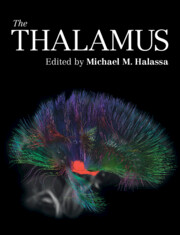Book contents
- The Thalamus
- The Thalamus
- Copyright page
- Contents
- Contributors
- Preface
- Section 1: History
- Section 2: Anatomy
- Section 3: Evolution
- Section 4: Development
- Section 5: Sensory Processing
- Chapter 9 Thalamocortical Interactions in the Primary Visual Cortex
- Chapter 10 Corticothalamic Feedback in Vision
- Chapter 11 The Vibrissa Sensorimotor System of Rodents: A View from the Sensory Thalamus
- Chapter 12 Corticothalamic Pathways in the Somatosensory System
- Chapter 13 Thalamocortical Circuits for Auditory Processing, Plasticity, and Perception
- Section 6: Motor Control
- Section 7: Cognition
- Section 8: Arousal
- Section 9: Computation
- Index
- References
Chapter 10 - Corticothalamic Feedback in Vision
from Section 5: - Sensory Processing
Published online by Cambridge University Press: 12 August 2022
- The Thalamus
- The Thalamus
- Copyright page
- Contents
- Contributors
- Preface
- Section 1: History
- Section 2: Anatomy
- Section 3: Evolution
- Section 4: Development
- Section 5: Sensory Processing
- Chapter 9 Thalamocortical Interactions in the Primary Visual Cortex
- Chapter 10 Corticothalamic Feedback in Vision
- Chapter 11 The Vibrissa Sensorimotor System of Rodents: A View from the Sensory Thalamus
- Chapter 12 Corticothalamic Pathways in the Somatosensory System
- Chapter 13 Thalamocortical Circuits for Auditory Processing, Plasticity, and Perception
- Section 6: Motor Control
- Section 7: Cognition
- Section 8: Arousal
- Section 9: Computation
- Index
- References
Summary
The cortex and thalamus are richly interconnected by feedforward and feedback pathways. For vision, the lateral geniculate nucleus (LGN) of the dorsal thalamus supplies the primary visual cortex with synaptically strong feedforward input that carries information about the external environment. The cortex, in turn, sends an even greater number of axons back to the LGN; however, these corticogeniculate inputs are relatively weak. Based on this anatomy, the cortex appears to be able to modulate the nature of the signals it receives from the LGN, potentially to meet the ongoing processing needs of the cortex. This chapter examines the relationship between the feedforward and feedback pathways interconnecting the LGN and visual cortex, with an emphasis on their organization with respect to the parallel processing streams originating in the retina. It also explores the influence of corticogeniculate feedback on vision.
- Type
- Chapter
- Information
- The Thalamus , pp. 206 - 213Publisher: Cambridge University PressPrint publication year: 2022

